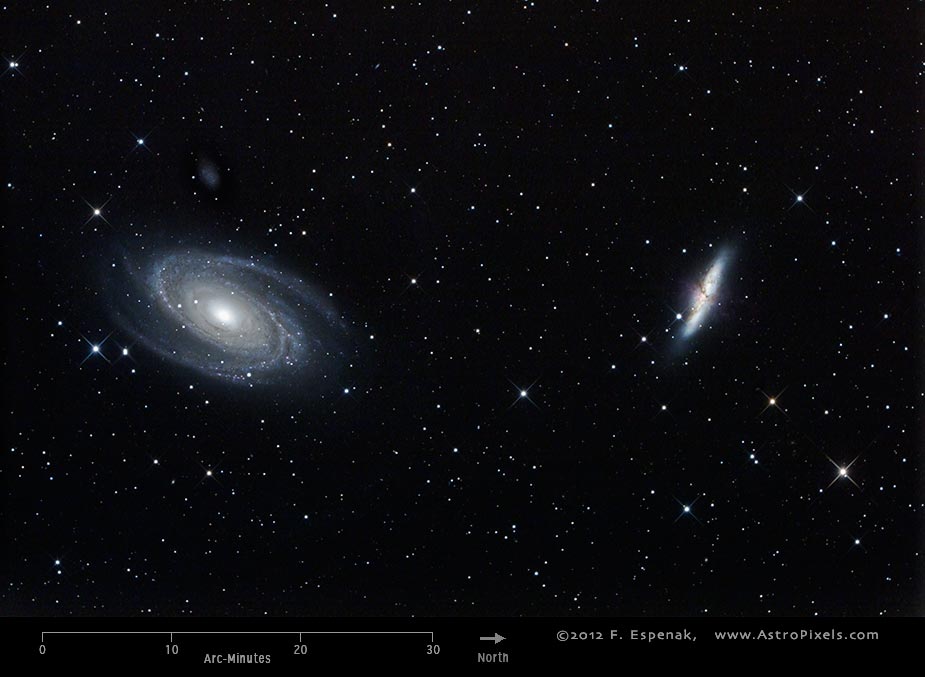M81 and M82
M81 and M82 are a pair of galaxies in the constellation Ursa Major. The pair are located approximately 10 degrees northwest of the "Big Dipper" pointer star Dubhe (Alpha Ursae Majoris). The apparent separation of the galaxies is 31 arc-minutes but at a distance of 12 million light-years, their actual distances from each other is 150,000 light years. They are the largest members of the M81 Group, a physical association of 34 galaxies.
M81 and M82 are best seen during the spring. The Messier Spring Star Chart shows the position of all Messier objects visible during that season.
The image above shows the uncropped view of M81 (left) and M82 (right) through the ASA N12 Corrected Newtonian Astrograph (North is to the right). For another image of this pair using the Takahashi E-180 Astrograph, see M81 and M82 (TAK E-180) .
M81 - Bode´s Galaxy
Messier 81 or M81 (also designated NGC 3031) is a spiral galaxy in the constellation Ursa Major. It has an apparent visual magnitude of 6.9 and its angular diameter is 21x10 arc-minutes. M81 lies at an estimated distance of 12 million light years. The Equinox 2000 coordinates are RA= 9h 55.6m, Dec= +69° 04´. As one of the more famous objects in the Messier Catalog, it is commonly known as the Bode´s Galaxy.
Although included in the Messier Catalog, this spiral galaxy was actually discovered by J. E. Bode in 1774. According to Stoyan et al. (2010), the distance of M81 is 11.8 million light years and its diameter is 92,000 light years. Its estimated mass is 50 billion solar masses. A close-up image of this galaxy is at M81 (ASA N12).
For more information, see the Messier Catalog as well as specific entries for M81 in Wikipedia and SEDS.
M82 - Cigar Galaxy
Messier 82 or M82 (also designated NGC 3034) is a starburst galaxy in the constellation Ursa Major. It has an apparent visual magnitude of 8.4 and its angular diameter is 9x4 arc-minutes. M82 lies at an estimated distance of 12 million light years. The Equinox 2000 coordinates are RA= 9h 55.8m, Dec= +69° 41´. As one of the more famous objects in the Messier Catalog, it is commonly known as the Cigar Galaxy.
In spite of its inclusion in the Messier Catalog, this peculiar galaxy was actually discovered by J. E. Bode in 1774. M82 has an irregular, distorted disk due to the gravitaional interaction of its larger neighbor M81. It is known as a starburst galaxy since it is the site of intense star-forming activity. According to Stoyan et al. (2010), the distance of M82 is 11.5 million light years and its diameter is 37,000 light years. Its estimated mass is 50 billion solar masses. A close-up image of this galaxy is at M82 (ASA N12).
For more information, see the Messier Catalog as well as specific entries for M82 in Wikipedia and SEDS.
Technical Details
- Objects: M81 and M82
- Other Names: M81: NGC 3031, Bode´s Galaxy; M82: NGC 3034, Cigar Galaxy
- Object Type: M81: spiral galaxy; M82: starburst galaxy
- Object Data: M81: Apparent Magnitude = 6.9, Angular Size = 21x10 arc-minutes; M82: Apparent Magnitude = 8.4, Angular Size = 9x4 arc-minutes
- Object Position (Equinox 2000): M81: RA= 9h 55.6m, Dec= +69° 04´; M82: RA= 9h 55.8m, Dec= +69° 41´ ; Constellation = Ursa Major
- Date/Time: 2012 Mar 22 at 03:11 UTC
- Location: Bifrost Astronomical Observatory, Portal, AZ
- Mount: Astro-Physics 1200GTO
- Telescope: ASA N12 Corrected Newtonian Astrograph
- Camera: Canon EOS 550D (Rebel T2i) (modified with a Baader UV/IR filter)
- Field of View: 71.0 x 47.4 arc-minutes at 0.82 arc-sec/pixel (web version: 4.6 arc-sec/pixel)
- Exposure: 10 x 420s, f/3.6, ISO 800
- File Name: M81M82-A01w.jpg
- Processing (Adobe Camera Raw): Flat Field Subtraction, Noise Reduction, White Balance
- Processing (Photoshop CS5): Average Images, Curves, Noise Reduction, High Pass Filter, Unsharp Mask
- Original Image Size: 3454 × 5179 pixels (17.9 MP); 11.5" x 17.3" @ 300 dpi
- Rights: Copyright 2012 by Fred Espenak. All Rights Reserved. See: Image Licensing.
